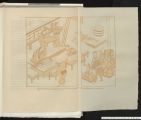| OCR Text |
Show OLD«PAPERMAKIN 3 that furnished locomotion to the stampers. Th water was usually filtered through a seriesof shallow boxes, each having an opening covered wit hair-cloth screening. The final treatment of th pulp was given by the last set of stampers whic was made of plain wood. At this stage no runnin water was supplied as the rags, by this time, wer sodisintegrated that much of the fibre would hav been lost through the strainers The stamping-mills were slowly developed fro the crude machinesuch as Boeckler pictured, unti a good German mill bad as many as twenty-fiv troughs with four stampers to each trough, whil some of the French machines had five stamper toeach receptacle. These stamping-millswere use for the maceration of rags by the early America papermakers but it is probable their use was discontinued in this countrya number of years befor they were entirely abandoned in Europe. Th Willcox mill was not established until 1727, but i is recorded that their first method of reducing rag to pulpwas by the use of a stamping-mill. Thiswa the third mill to have been set up in Pennsylvania It is not known when the stamping-mills were discarded in America but it is thought they remaine in action until about the year 1780. With the us of these old machines the fibres of the rags wer slowly drawn out almost full length, which is on of the reasons papers of the stamping-mill perio Diital imag © 2004 Marriot Libary, University o Utah. Al righs reserved |
































































































































































